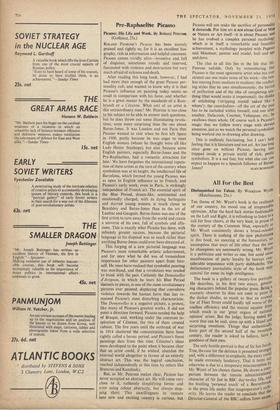Pre-RapItaelihe Picasso
Picasso: His Life and Wolk. By Roland Penrose. (Gollancz, 25s.) ROLAND PENROSE'S Picasso has been warmly praised and rightly so, for it is an excellent bio- graphy, rich in information and helpful comment. Picasso comes vividly alive—inventive and full of disguises, sometimes moody and reserved, fascinated with violence and destruction but very much afraid of sickness and death.
After reading this long book, however, I had had more than enough of the great Picasso per- sonality cult, and wanted to know why it is that Picasso's influence on painting today seems so small in comparison with his fame, and whether he is a great master by the standards of a Rem- brandt or a Cezanne. What sort of an artist is this extraordinary man? Mr. Penrose is too close to his subject to be able to answer such questions, but he does throw out some illuminating revela- tions, none more surprising than the one about Burne-Jones. It was London and not Paris that Picasso wanted to visit when he first left Spain in 1900, partly because he was eager to meet English women (whom he thought were all like Lady Hester Stanhope), but also 'because some English painters, especially Burne-Jones and the Pre-Raphaelites, had a romantic attraction for him.' We have forgotten the international reputa- tion of these artists at the turn of the century when symbolism was at its height; the intellectual life of Barcelona, which formed the young Picasso, was as open to English influence as to French, and Picasso's early work, even in Paris, is strikingly independent of French art. The essential spirit of the Blue Period, dream-like, sentimental and emotionally charged, with its dying harlequins and starved young women, is much closer to Beardsley and Burne-Jones than to the art of Lautrec and-Gauguin. Burne-Jones was one of the first artists to turn away from the world and create a universe of his own, full of symbols and allu- sions. This is exactly what Picasso has done, with infinitely greater success, because the pictorial language at his disposal was so much richer than anything Burne-Jones could ever have dreamed of.
This forging of a new pictorial language was Picasso's most remarkable artistic achievement, and for once what he did was of tremendous importance for other painters apart from him- self. He must have realised that symbolist painting was moribund, and that a revolution was needed to break with the past. Certainly the Demoiselles d'Avignon, in which he tears his Blue Period damsels to pieces, is one of the most revolutionary pictures ever painted, displaying that convulsive
violence towards the human form that has re- mained Picasso's most disturbing characteristic.
The Demoiselles is a negative picture, a protest, like many of Picasso's greatest works. It did not point a direction forward. Picasso needed the help of Braque, and, working under the common in- spiration of Cezanne, the two of them created cubism. The five years until the outbreak of war in 1914 shattered the concentration have been rightly called a heroic period, and Picasso's finest paintings date from this time. Cezanne's ideas were developed to the point when it became clear that an artist could, if he wished, abandon the external world altogether in favour of an entirely
abstract art. This was the logical conclusion, reached independently at this time by others like Brancusi and Kandinsky.
. But, as Mr. Penrose makes clear, Picasso has never accepted an abstract art. He will come very
close to it, ruthlessly simplifying forms and even using colour abstractly, but always stop- ping short. This unwillingness to venture into new and exciting country is curious, but
Picasso will not make the sacrifice of personality it demands. For him art is not about God or Mao or Nature or Art itself—it is about Picasso, and he has evolved a complex personal mythologY which is in itself a remarkable and beautiful achievement, a mythology peopled with Pegasus and Minotaur, painter and model, bull and ape and dove.
The clue to all this lies in the life that Mr. Penrose unfolds. Only by remembering that Picasso is the most egocentric artist who has ever existed can one make sense of his work—the rest- less moving from medium to medium; the conflict. ing styles that he uses simultaneously; the hatred of perfection and of the idea of completing any thing (that would make it impersonal); the dislike of exhibiting (`stripping myself naked -like a whore'); the cannibalism—all the art of the past has to be included within himself, and one after another, Delacroix, Courbet, Velasquez, etc., he swallows them whole. Of course such is Picasso's magic that we follow every stage with devout attention, just as we watch the personal symbolism being worked out in drawing after drawing.
This is endlessly fascinating, but I can't help feeling that it is literature and not art. Art has long since gone on without Picasso, leaving him trapped inside a private world of rich, poetic symbolism. It is a sad fate, but what else can YOU expect to happen to a Spanish f011ower of Burne-














































































 Previous page
Previous page